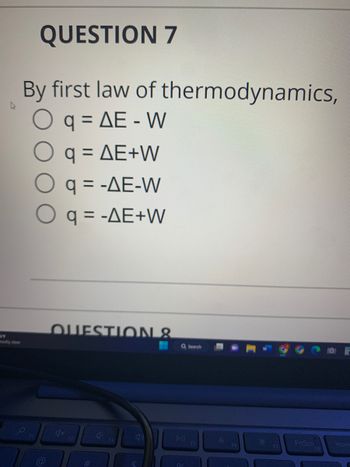
Chemistry
10th Edition
ISBN: 9781305957404
Author: Steven S. Zumdahl, Susan A. Zumdahl, Donald J. DeCoste
Publisher: Cengage Learning
expand_more
expand_more
format_list_bulleted
Question
thumb_up100%

Transcribed Image Text:QUESTION 7
4
By first law of thermodynamics,
O q = AE - W
q = AE+W
O q = -AE-W
O q = -AE+W
QUESTION &
F2
#
F3
Q Search
0/
F5
Ö
F6
**
F7
PrtScn
Hom
Expert Solution
This question has been solved!
Explore an expertly crafted, step-by-step solution for a thorough understanding of key concepts.
Step by stepSolved in 2 steps

Knowledge Booster
Learn more about
Need a deep-dive on the concept behind this application? Look no further. Learn more about this topic, chemistry and related others by exploring similar questions and additional content below.Similar questions
- Trinitrotoluene (TNT) is a highly explosive compound. The thermal decomposition of TNT is described by the following chemical equation: The enthalpy change for the explosion of ammonium nitrate with fuel oil is –7198.00 kJ for 3 moles of NH4NO3. If ΔHrxn for the thermal decomposition of 2 moles of TNT is –20,306.00 kJ, how much TNT is needed to equal the explosive power of 1 mole of ammonium nitrate? g TNTarrow_forwardThe heat of combustion of propan-2-ol at 298.15 K, determined in a bomb calorimeter, is -33.41kJ/g. For the combustion of one mole of propan-2-ol, determine ΔrH. Express your answer using four significant figures.arrow_forwardAn ideal gas sealed in a rigid 3.13-L cylinder, initially at pressure Pi=12.70 atm, is cooled until the pressure in the cylinder is Pf=1.18 atm. What is the enthalpy change for this process?What is the change in internal energy for this process?arrow_forward
- The standard molar enthalpy of formation for oxygen gas, ?2(?), is zero. The enthalpy of formation for atomic oxygen, ?(?), is +250??/???. Why is there a difference in these values?arrow_forward55. Does the standard enthalpy of formation of H2O(g) differ from ΔH° for the reaction 2H2(g)+O2(g)⟶2H2O(g)?arrow_forwardIf a system has 5.00×102 kcal5.00×102 kcal of work done to it, and releases 5.00×102 kJ5.00×102 kJ of heat into its surroundings, what is the change in internal energy (Δ? or Δ?)(ΔE or ΔU) of the system?arrow_forward
- to calculate the true enthalpies of these reactions by the Hess’ law, as: ΔH°(rxn) = Σ[ν × ΔHf°(product)] – Σ[ν × ΔHf°(reactant)] for: Mg(s) + ½O2(g) → MgO(s)arrow_forwardHess's Law Given the following data: 4C(s) + 3H2(g) + 1/2O2(g) → HCOC(CH2)(CH3)(l) ΔH°=-139.0 kJ CH3CH2OH(l) + 1/2O2(g) → CH3CHO(l) + H2O(l) ΔH°=-204.0 kJ 2C(s) + 3H2(g) + 1/2O2(g) → CH3CH2OH(l) ΔH°=-278.0 kJ H2(g) + 1/2O2(g) → H2O(l) ΔH°=-286.0 kJ calculate ΔH° for the reaction:2CH3CHO(l) → HCOC(CH2)(CH3)(l) + H2O(l)arrow_forwardIf a system has 225 kcal of work done to it, and releases 5.00 x 102 kJ of heat into its surroundings, what is the change in internal energy (AE or AU) of the system? ΔΕ- kJarrow_forward
arrow_back_ios
arrow_forward_ios
Recommended textbooks for you
 ChemistryChemistryISBN:9781305957404Author:Steven S. Zumdahl, Susan A. Zumdahl, Donald J. DeCostePublisher:Cengage Learning
ChemistryChemistryISBN:9781305957404Author:Steven S. Zumdahl, Susan A. Zumdahl, Donald J. DeCostePublisher:Cengage Learning ChemistryChemistryISBN:9781259911156Author:Raymond Chang Dr., Jason Overby ProfessorPublisher:McGraw-Hill Education
ChemistryChemistryISBN:9781259911156Author:Raymond Chang Dr., Jason Overby ProfessorPublisher:McGraw-Hill Education Principles of Instrumental AnalysisChemistryISBN:9781305577213Author:Douglas A. Skoog, F. James Holler, Stanley R. CrouchPublisher:Cengage Learning
Principles of Instrumental AnalysisChemistryISBN:9781305577213Author:Douglas A. Skoog, F. James Holler, Stanley R. CrouchPublisher:Cengage Learning Organic ChemistryChemistryISBN:9780078021558Author:Janice Gorzynski Smith Dr.Publisher:McGraw-Hill Education
Organic ChemistryChemistryISBN:9780078021558Author:Janice Gorzynski Smith Dr.Publisher:McGraw-Hill Education Chemistry: Principles and ReactionsChemistryISBN:9781305079373Author:William L. Masterton, Cecile N. HurleyPublisher:Cengage Learning
Chemistry: Principles and ReactionsChemistryISBN:9781305079373Author:William L. Masterton, Cecile N. HurleyPublisher:Cengage Learning Elementary Principles of Chemical Processes, Bind...ChemistryISBN:9781118431221Author:Richard M. Felder, Ronald W. Rousseau, Lisa G. BullardPublisher:WILEY
Elementary Principles of Chemical Processes, Bind...ChemistryISBN:9781118431221Author:Richard M. Felder, Ronald W. Rousseau, Lisa G. BullardPublisher:WILEY

Chemistry
Chemistry
ISBN:9781305957404
Author:Steven S. Zumdahl, Susan A. Zumdahl, Donald J. DeCoste
Publisher:Cengage Learning

Chemistry
Chemistry
ISBN:9781259911156
Author:Raymond Chang Dr., Jason Overby Professor
Publisher:McGraw-Hill Education

Principles of Instrumental Analysis
Chemistry
ISBN:9781305577213
Author:Douglas A. Skoog, F. James Holler, Stanley R. Crouch
Publisher:Cengage Learning

Organic Chemistry
Chemistry
ISBN:9780078021558
Author:Janice Gorzynski Smith Dr.
Publisher:McGraw-Hill Education

Chemistry: Principles and Reactions
Chemistry
ISBN:9781305079373
Author:William L. Masterton, Cecile N. Hurley
Publisher:Cengage Learning

Elementary Principles of Chemical Processes, Bind...
Chemistry
ISBN:9781118431221
Author:Richard M. Felder, Ronald W. Rousseau, Lisa G. Bullard
Publisher:WILEY